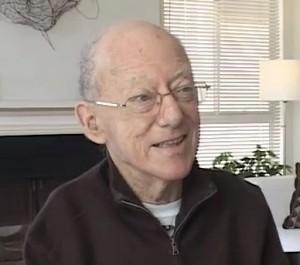One evening last month I drove to a neighborhood near Otis College to visit Bud Goldstone and his wife Arloa in hopes of retracing Bud’s long history with the Watts Towers. To give you a sense of Bud’s relationship to Simon Rodia and Towers, he is the proud owner of Rodia’s gas fitter pliers, which the artist used to build his sculptures!
Who wouldn’t want to meet a man who concludes every email with the following signature: “Bud Goldstone; OSU, Purdue Aero Engr; AIC Pro. Assoc.-retired; Apollo Engineering, 'The Los Angeles Watts Towers', pub by Getty Museum & Conservation Institute; "Secrets of Watts Towers"; SPACES Archives”

Bud Goldstone
In order to understand what all of that means, I sat in their kitchen enjoying Bud’s passion for the history of the Towers. Trained as an aeronautical engineer Norman J. “Bud” Goldstone had been in Los Angeles for about ten years when he read an article in the paper about Rodia’s sculptures. Bud was “not so impressed by the towers” and, at first, didn’t get caught up in their artistic mastery; it was more that the published quotes by his colleagues—other engineers—were to his way of thinking just not accurate. He felt that the engineers “didn’t know what they were talking about,” and he wanted to see for himself what was going on. It was this desire for professional accuracy that first urged him to drive to 107th Street in South Central to see what these monuments were about and what the engineers were saying. Ultimately, he saw ways in which he might make a contribution to the project.
Bud had no idea that this first visit would eventually lead to a lifetime of devoted advocacy and work for Simon Rodia’s environment. Made of concrete, metal, and miscellany, Bud discovered what he likes to call “a three-dimensional doodle.”
During our visit Bud didn’t spend much time talking about his decisive action in 1959 that ultimately saved the Towers and was the primary reason why they are still standing today (recounted in more depth in The Los Angeles Watts Towers). Set by the City of Los Angeles Building and Safety Department for demolition in 1957, by 1959, a grassroots effort was growing to save the Towers. Because Bud had engineering expertise he was pulled into the effort, which comprised artists, community members, students, and activists. On October 10, 1959 a load test was conducted in front of more than 1,000 people; the experimental stress test used 10,000 pounds of pressure to pull down the Tower. The tower bowed, but did not fall, before the truck and the beam involved with the test started to bend and bow. Witnessing that the Towers were not going to be destroyed, the city defined the test a success for the Preservationists. Engineer Bud was the hero of the day!
Bud told us when the Building and Safety Department voted for the load test, fifteen were against and sixteen were for it.
Bud had the honor and distinction, he said while we sat in his apartment, of meeting the artist, Simon Rodia (1879–1965). Bud recalls taking him to dinner on two occasions and that Rodia was “wonderful,” “lovable,” and that the two of them “had a ball together.” I will remember my evening with Bud and Arloa in a very similar light!
Brooke Davis Anderson, Deputy Director of Curatorial Planning



